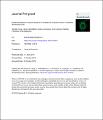| dc.contributor.author | Yang, Tiantian | |
| dc.contributor.author | Hämäläinen, Jarmo | |
| dc.contributor.author | Lohvansuu, Kaisa | |
| dc.contributor.author | Lipponen, Arto | |
| dc.contributor.author | Penttonen, Markku | |
| dc.contributor.author | Astikainen, Piia | |
| dc.date.accessioned | 2021-01-14T14:16:29Z | |
| dc.date.available | 2021-01-14T14:16:29Z | |
| dc.date.issued | 2021 | |
| dc.identifier.citation | Yang, T., Hämäläinen, J., Lohvansuu, K., Lipponen, A., Penttonen, M., & Astikainen, P. (2021). Deviance detection in sound frequency in simple and complex sounds in urethane-anesthetized rats. <i>Hearing Research</i>, <i>399</i>, Article 107814. <a href="https://doi.org/10.1016/j.heares.2019.107814" target="_blank">https://doi.org/10.1016/j.heares.2019.107814</a> | |
| dc.identifier.other | CONVID_33252011 | |
| dc.identifier.uri | https://jyx.jyu.fi/handle/123456789/73630 | |
| dc.description.abstract | Mismatch negativity (MMN), which is an electrophysiological response demonstrated in humans and animals, reflects memory-based deviance detection in a series of sounds. However, only a few studies on rodents have used control conditions that were sufficient in eliminating confounding factors that could also explain differential responses to deviant sounds. Furthermore, it is unclear if change detection occurs similarly for sinusoidal and complex sounds. In this study, we investigated frequency change detection in urethane-anesthetized rats by recording local-field potentials from the dura above the auditory cortex. We studied change detection in sinusoidal and complex sounds in a series of experiments, controlling for sound frequency, probability, and pattern in a series of sounds. For sinusoidal sounds, the MMN controlled for frequency, adaptation, and pattern, was elicited at approximately 200 ms onset latency. For complex sounds, the MMN controlled for frequency and adaptation, was elicited at 60 ms onset latency. Sound frequency affected the differential responses. MMN amplitude was larger for the sinusoidal sounds than for the complex sounds. These findings indicate the importance of controlling for sound frequency and stimulus probabilities, which have not been fully controlled for in most previous animal and human studies. Future studies should confirm the preference for sinusoidal sounds over complex sounds in rats. | en |
| dc.format.mimetype | application/pdf | |
| dc.language | eng | |
| dc.language.iso | eng | |
| dc.publisher | Elsevier | |
| dc.relation.ispartofseries | Hearing Research | |
| dc.rights | CC BY-NC-ND 4.0 | |
| dc.subject.other | auditory cortex | |
| dc.subject.other | change detection | |
| dc.subject.other | local-field potentials | |
| dc.subject.other | mismatch negativity | |
| dc.subject.other | rats | |
| dc.title | Deviance detection in sound frequency in simple and complex sounds in urethane-anesthetized rats | |
| dc.type | research article | |
| dc.identifier.urn | URN:NBN:fi:jyu-202101141106 | |
| dc.contributor.laitos | Psykologian laitos | fi |
| dc.contributor.laitos | Department of Psychology | en |
| dc.contributor.oppiaine | Psykologia | fi |
| dc.contributor.oppiaine | Monitieteinen aivotutkimuskeskus | fi |
| dc.contributor.oppiaine | Hyvinvoinnin tutkimuksen yhteisö | fi |
| dc.contributor.oppiaine | Psychology | en |
| dc.contributor.oppiaine | Centre for Interdisciplinary Brain Research | en |
| dc.contributor.oppiaine | School of Wellbeing | en |
| dc.type.uri | http://purl.org/eprint/type/JournalArticle | |
| dc.type.coar | http://purl.org/coar/resource_type/c_2df8fbb1 | |
| dc.description.reviewstatus | peerReviewed | |
| dc.relation.issn | 0378-5955 | |
| dc.relation.volume | 399 | |
| dc.type.version | acceptedVersion | |
| dc.rights.copyright | © 2019 Elsevier B.V. All rights reserved. | |
| dc.rights.accesslevel | openAccess | fi |
| dc.type.publication | article | |
| dc.relation.grantnumber | 322114 | |
| dc.subject.yso | havaitseminen | |
| dc.subject.yso | häiriöt | |
| dc.subject.yso | kuulo | |
| dc.subject.yso | koe-eläinmallit | |
| dc.subject.yso | ääni (fysikaaliset ilmiöt) | |
| dc.subject.yso | aivokuori | |
| dc.subject.yso | elektrofysiologia | |
| dc.subject.yso | ärsykkeet | |
| dc.subject.yso | taajuus | |
| dc.format.content | fulltext | |
| jyx.subject.uri | http://www.yso.fi/onto/yso/p5293 | |
| jyx.subject.uri | http://www.yso.fi/onto/yso/p544 | |
| jyx.subject.uri | http://www.yso.fi/onto/yso/p1937 | |
| jyx.subject.uri | http://www.yso.fi/onto/yso/p28104 | |
| jyx.subject.uri | http://www.yso.fi/onto/yso/p4572 | |
| jyx.subject.uri | http://www.yso.fi/onto/yso/p7039 | |
| jyx.subject.uri | http://www.yso.fi/onto/yso/p7871 | |
| jyx.subject.uri | http://www.yso.fi/onto/yso/p2943 | |
| jyx.subject.uri | http://www.yso.fi/onto/yso/p704 | |
| dc.rights.url | https://creativecommons.org/licenses/by-nc-nd/4.0/ | |
| dc.relation.doi | 10.1016/j.heares.2019.107814 | |
| dc.relation.funder | Research Council of Finland | en |
| dc.relation.funder | Suomen Akatemia | fi |
| jyx.fundingprogram | Postdoctoral Researcher, AoF | en |
| jyx.fundingprogram | Tutkijatohtori, SA | fi |
| jyx.fundinginformation | This work was supported by the China Scholarship Council (personal grant for Tiantian Yang) and the Academy of Finland (grant number 322114 for Kaisa Lohvansuu). | |
| datacite.isSupplementedBy | Lohvansuu, Kaisa; Astikainen, Piia. <i>Psychophysiological data from AudPath project (Dynamics and plasticity of the auditory pathway in auditory perceptual learning of speech sounds)
</i>. V. 26.10.2021. | |
| datacite.isSupplementedBy | Lohvansuu, Kaisa; Astikainen, Piia. AudPath_IC2. V. 26.10.2021. | |
| dc.type.okm | A1 | |

